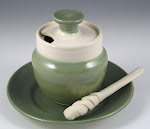Tinker Mountain Arts Women Working with Clay Symposium at Hollins University, Roanoke, Virginia, June 10-13, 2013. (Donna Polseno, originator and coordinator. Moira Vincentelli, Wales, keynote)
My head is still spinning and the experiences are going to take some processing. Because we were only 38 attendees at this intense symposium, up close and personal to the activity, absorbing and sharing sights, ideas, techniques, discussions, images and insights at an astounding rate, here is the broadest overview, in intro.
Five women artists creating with clay worked through the days (Monday afternoon through Thursday morning) of the symposium, interacting in ways that allowed the attendees to watch, talk, photograph, ask, think, speculate. Yowza. I may be temporarily losing my marbles, because there was so much to gather. I will give you some words and photos, and hope you will connect the dots...and remember, click on any photo for a larger image.
(Below) Sandy Simon (Trax Gallery, Berkeley). Spontaneity laced with practical experience. Red earthenware, white slip, nichrome wire, potter's wheel. Vessels nearly complete right on the wheel. Marketing. Advice. No fear. Adventure.
 |
| Sandy adding a wire & button handle right on the damp pot |
 |
| A tray of Sandy Simon's pots |
(Below) Stacy Snyder: Architecture and textured clay. Potter's wheel. Altering, squaring off. Added surface images. Discussion of the balance of motherhood and making art. Purposeful.
 |
| Stacy throwing a form she will dramatically alter |
 |
| Stacy Snyder house jar with decals applied |
(Below) Charity Woodard-Davis: Wood-fire. Porcelain. Slip that flashes orange in the kiln. Contradictions: Formality/organic shapes. Meticulously made vessels/entrusted to the prolonged vagaries of the wood-fired kiln environment. Fiercely magnificent work. (I bought a marvelous cup, not shown.)
 |
| Charity Davis-Woodard assembling a ewer |
 |
| Charity's cup, just assembled |
(Below) Cheryl Ann Thomas: Teeny tiny coils pinched from porcelain clay. Non-vessels with vessel-like conical structures when first crafted. So thin, so textured with tiny undulations. Delicate walls folding and falling into sculpture in the deforming heat of the kiln. Slow, patient construction then ceding to the kiln the right to distort quickly and capriciously. Elegant and so crazy it made sense. Sheer outrageous simplicity. Rules + breaking rules = half-controlled half-uncontrolled. Surprise!
 |
| Cheryl Ann Thomas begins constructing her sculpture |
 |
| Cheryl Ann's sculpture rises slowly from tiny coils |
(Below) Adrian Arleo: Woman figure pinched out of big, fat coils over two days. Groggy, nylon-fiber-reinforced clay. No blueprints, no rulers, figure constructed from the bottom up to the head. Deftness. Strength. That certain unseen something in an artist's head that emerges through the medium.
 |
| Adrian working on a figure, starting at the bottom & working upward |
 |
| The seated figure begins to get legs |
All five differed from one another so much. Clay is servant to individual goals. The artists, well-versed and exceptionally connected to the medium and techniques they were using, each took us into their own clay stories. We attendees each had our own stories and some of this we shared with each other as well over the 3 days. It was a seizure of so much muchness I will have to parse it over time.














































